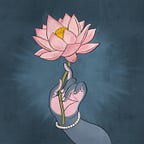Banī-ṭhanī and the Kishangarh School
“Peacocks sing in the pure moonlight.
Over and over the song echoes in Vṛndāvan; the mountain and all its caves respond —
A symphony that brings great bliss; the last watch of the night remains.
Nāgarīdās sees Shyāma and Shyāmā during their love-play in their unattainably high loft.”
Pad-prasaṅg-mālā 63
A fascinating aspect of the Kishangarh school of painting is its portrayal of Krishna with the traits of its crown prince, Sāvant Singh (1699–1764), and in the style of Sāvant Singh’s poetry. Sāvant Singh was a patron who inspired the local painters, most famously Nihālcand, to develop the new, exquisite style dominated by the depiction of Rādhā-Krishna vignettes, frequently for illustration of his own poetry. As an ardent Rādhā-Krishna devotee, he composed, under the pen name Nāgarīdās, or “Servant of Rādhā,” two volumes of poetry in praise of the divine pair. In the commissioned paintings, Krishna often has the same facial features as Sāvant Singh in his (probably flattering) portraits. Some believe that the long-nosed and elongated-eyed Rādhā, too, is based on a real person at the court: Sāvant Singh’s young mistress, Vishnupriya, nicknamed Banī-ṭhanī, or one who was “beautifully made up”.
Nihālcand, in painting the bhakti themes of Krishna and Rādha, gave expression to the deepest concerns of the Kishangarh royal family. He was seminal in the development of the now-famous Kishangarh style, characterized particularly by slender, attenuated arching human figures with an elongated face, slender features and markedly upward curving eyes with partially closed lids. The suggestion that the distinctive facial type of the Kishangarh Rādha was modelled after descriptive cues found in poetry is untenable because the descriptions of the idealised feminine figure in Sanskrit poetry and in the poems of Savant Singh are so conventional and generalised that the visual cues cannot yield this very distinctive visage. Following that line of reasoning, we would have seen the style recurring in Rajasthani and Pahari painting which maintained close proximity with this poetic tradition. Further, Savant Singh himself was something of a painter, though by no means a distinguished one, and some of his sketches suggest that he was experimenting with various ways of depicting the eyes. The traditional treatment obviously did not satisfy him, probably because it did not do justice to the eyes of his own Rādha. The painting of Savant Singh and Banī-ṭhanī in a palace courtyard has all indications of being based on real life study and the profile of the latter seems to be the undeniable model for the iconic Kishangarh Rādha.
Banī-ṭhanī was also an ardent devotee who composed poetry under the pseudonym Rasik Bihārī. Savant Singh and his mistress both celebrated their own love and that of Rādhā and Krishna in their poetry. The boundaries between temple and court were fluid: as God was modeled after royalty, the royalty modeled themselves after God. If the Kishangarhi lovers went boating on a lake, so did Rādhā and Krishna in Nāgarīdās’s poem Love-Play’s Moonlight (Bihār-candrikā) and the matching painting Boat of Love. And if Krishna dallied in the bucolic Vrindavan with Rādhā, so did the humans. Sāvant Singh went on frequent pilgrimages to Vrindavan and eventually retired there toward the end of his life, and we know that Rasik Bihārī accompanied him, having earned his place in Krishna’s eternal forest of Vṛndāvana. As he says in one of his late songs, which remains a favorite in the Rās-līlās staged today:
“Everything has worked out in the end!
Śrī Kuñjabihārini and Śrī Kuñjabihārī took mercy on me:
They’ve kept me safe in their Vrindavan, a place of splendid beauty.
Constant bliss in their eternal play, to delight in with fellow-rasikas.
A realm apart from the world, devoid of strife and sorrow.
Let Nāgarīdās live out his life, forever devoted to Braj.”
Ban-jan-praśaṃśak
Sāvant Singh’s samādhi located near Nagari Kunj, his residence in Vrindāvan bears an inscription which reads as follows:
“Śrī Nātha Jī
Rādhā’s Krishna, Mountain-Holder, roaming on Vrindavan’s riverbanks, Darling of Lalitā and other friends, Lord Viṭṭhala, Mohana, let your mercy flow.
Sāvant Singh was king in Kali Yuga, yet set an example for all:
He gave his son the kingdom, while he himself retired to Vrindavan.
The Lord of Rupnagar had a flock of devotees, whom he cherished lovingly.
He was a hero, profound in thought, and he delighted devotees.
As a rule, he humbly drank water used to wash the feet of holy men. The sacred songs he sang amount to an ocean.
Famous to the world as Nāgarīdās, he was handsome by the flowing grace of Rādhā (Nāgarī).
In 1821 VS, on the second day of the bright half of Bhādon, Mahārāja
Nāgarīdāsjī reached (the divine) Vṛndāvana.”
The Banī-ṭhanī style became so popular that later on, women of royalty would adopt the same style for the rendering of their portraits, as seen in the painting below.
Gouache on paper heightened with gilt, the young woman is shown holding a flower in her henna-dyed fingers and wearing elaborate pearl jewelery and clothing.
References:
History of Indian Painting: Rajasthani Traditions. India: Abhinav Publications, 1992.
Pauwels, Heidi. Mobilizing Krishna’s World: The Writings of Prince Sāvant Singh of Kishangarh. United States: University of Washington Press, 2017.
__________________________________________
If you find value in my work, I hope you consider becoming a patron or making a contribution via UPI to hindu.aesthetic@okicici. Hindu Aesthetic requires a lot of time and effort and your support would mean that I can continue bringing you the best possible content. ❤
